Shop Smart
Shopping Essentials
- When you have a shopping list. Stick to the list. (See the Plan Smart section for shopping list tips.)
- No more than once a week.
- When the store is least crowded.
- When you have time to compare the nutrition and prices of similar foods.
- After having a healthy meal or snack, not when you are hungry or thirsty.
- When you can go alone. Have a friend or adult family member keep your children. If you need to shop with children, teach them shopping skills so they can help. (See Shop with Children under Child-Friendly Tips.)
- On double or triple coupon days.
- Where you find the best prices. Find prices at stores, online, in newspaper inserts and in your price book.
- Include the cost of gas when deciding where to shop.
- Check prices at discount and dollar stores for items like cleaning supplies, personal-care products and pet food.
- Check out farmers’ markets and food co-ops.
- Look into stores that offer loyalty cards.
- If you use coupons, look for stores that offer double- or triple-coupon days.
- Buy only as much as you have budgeted for the shopping trip.
- Buy only the amount of food you will eat while it is fresh.
- Bigger packages often cost less per unit of contents. Compare unit prices to be sure. Divide large packages into smaller serving sizes and store them for later use. Buying big packages may encourage you to eat larger portions.
- Buying from bulk bins lets you choose how much to buy and usually costs less per unit.
- Only what is on your shopping list.
- Nutrient-rich foods. Read and compare Nutrition Facts labels. (Read about Nutrition Facts labels in the following sections.)
- Store or generic brands. Many are the same or very similar in quality and nutrition to national brands.
- The least-expensive form of food that will work for you (fresh, frozen or canned).
- The freshest food possible. Check sell-by and use-by dates.
- Items marked low salt, low fat, reduced sugar, packed in water or packed in natural juice.
- Impulse items—things that catch your attention but are not on your list.
- Convenience foods—foods that are fully or partially prepared when you buy them, such as boxed casserole mixes, precooked roasted chicken or premade sandwiches or salads. They are almost always more expensive than foods you make from scratch. They are also often higher in fat, sodium and sugar and lower in fiber and other nutrients.
- Bulging, swollen, rusty or severely dented cans.
- Foods with little nutritional value such as chips, candy, cookies and soda.
Five Money-Saving Tips
Unit price is the cost of a product per unit of weight, volume or other measure of quantity. It is usually posted on the shelf below the food. Use unit price to find the best buy among different brands and different sizes of the same brand.
Here are two unit price labels:
|
Store-brand snack crackers |
Name-brand snack crackers |
|---|---|
|
$2.00 |
$2.39 |
| 16 ounces | 12 ounces |
| $0.13/oz | $0.20/oz |
If the unit price is not posted, you can figure it out yourself. Divide the total price of the product by the total weight, volume or other unit of product.
Suppose a 29-ounce can of peaches costs $1.45.
The unit price is $1.45 ÷ 29 ounces = $0.05 per ounce, or 5 cents per ounce.
Keep track of the prices of foods you use often. Note the price at each store where you shop. When a food in your price book is advertised in a sale, you will know if it is a good deal or not. If it is — and you have extra food money — you can stock up. When you know regular prices, you can also quickly spot when a “buy one, get one free” sale is a good deal.
- Clip coupons for foods you use often. Most coupons are for name brands, and you may find less-expensive store brands. Coupons for basic ingredients such as vegetables, fruits and dairy products are not common.
- If you use a coupon, make sure the cashier scans it.
- Only go down aisles that have food on your list. Learn the store layout so you can find food quickly. Basic foods are around the outside edges of the store.
- Look at the high and low shelves for bargains and healthier choices.
- More-costly and less-healthy foods are placed at eye level.
- Be aware of displays at the ends of aisles. They often feature impulse items with “special” pricing.
- Resist magazines, candy and other impulse items.
- Watch for scanning errors, coupon deductions and correct change.
- Check your receipt for accuracy before leaving the store.
Shopping Smart by Food Group
- Buy fresh fruits in season, when they cost less and taste better. Check farmers’ markets for seasonal fruits. (Print the Seasonal Products Guide (PDF).)
- Choose frozen and canned fruits (canned in juice or water) and concentrated juice.
- Compare the prices of similar foods such as plums and peaches.
- Buy fresh vegetables in season. (Print the Seasonal Products Guide (PDF).)
- Whole vegetables and salad greens are usually less expensive and stay fresh longer than cut-up vegetables and salad mixes.
- Buy frozen and canned vegetables with less salt.
- Think about planting a garden. Read about gardening in Idaho at the Idaho Landscapes and Gardens website.
- Day-old bread costs less and is still a healthy choice.
- Buy regular rice and oatmeal rather than instant.
- Choose whole-grain bread, cereal, pasta, crackers and brown rice.
- Meat is one of the most-expensive foods. Watch for sales.
- Large packages of meat may be cheaper on sale. Divide the meat into meal-size packages and freeze it for later.
- Use less-expensive cuts of meat in soups, stews, stir-fries and slow-cooker dishes. Less-expensive cuts of beef include flank steak, skirt steak, brisket, chuck steak or roast, ribs and round or top round steak or roast.
- Dried beans are a good source of protein and fiber, inexpensive and won't spoil.
- Eggs and nuts are good sources of protein.
- Choose fat-free or low-fat (1 percent) milk, yogurt, and cheese.
- Larger packages of milk, cheese and yogurt cost less per unit than smaller packages. Buy the largest size you can eat while it’s fresh.
- Try ultra-pasteurized milk, evaporated skim milk and nonfat dry milk. They have long shelf lives.
- Freeze milk and shredded cheese to preserve them. Pour a small amount of milk out of the container before freezing to allow space for expansion.
Food Safety for Shopping
Keep your food safe while shopping, going home, and putting food away.
- Make food shopping your last stop before going home.
- Buy nonfood items and nonperishable food first. Buy refrigerated food next and frozen food last.
- Check each item for sell-by and use-by dates. Choose the food with the longest shelf life.
- Bag cold items together and place them in the coolest part of your car. If you live more than 30 minutes from where you shop, put cold items in a cooler, especially in hot weather.
- Put cold food away first when you get home.
- Put new foods behind older ones in the pantry, refrigerator and freezer so you can easily use older food first.
Using the Nutrition Facts Label
The Nutrition Facts Label is a great tool for comparing foods and making healthy food choices. Follow this step-by-step guide to reading the label.
The serving size for both the chili and the macaroni and cheese is 1 cup. The chili contains 2 servings per can, and the box of prepared macaroni and cheese makes 3 servings. Compare a “serving” with how much you eat. You may eat more or less than the listed serving size.
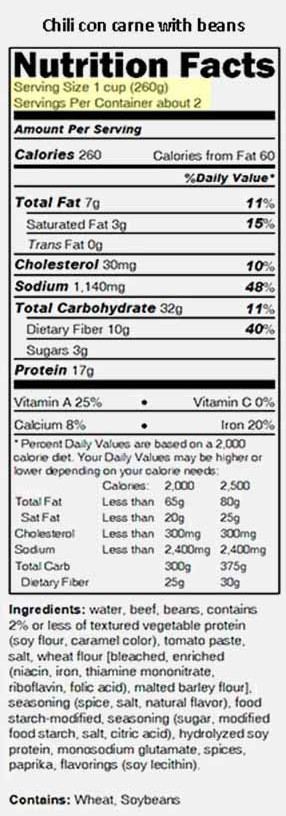
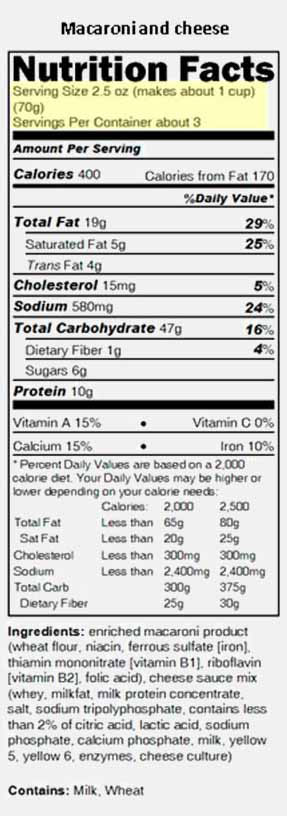
Quiz—
How many calories are in a whole can of chili? (520 calories)
How many calories are in a whole prepared box of macaroni and cheese? (1,200 calories)
These numbers show how many calories are in one serving of food and how many of those calories are from fat.
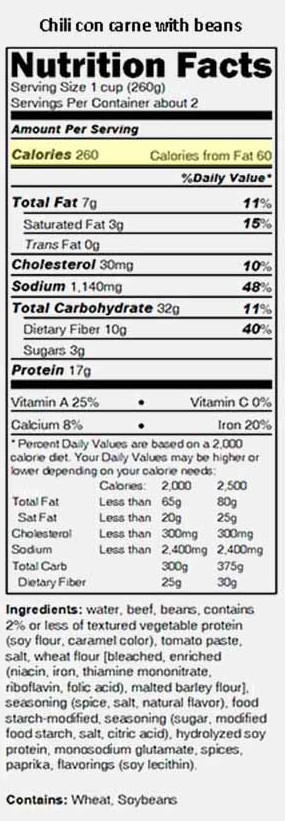
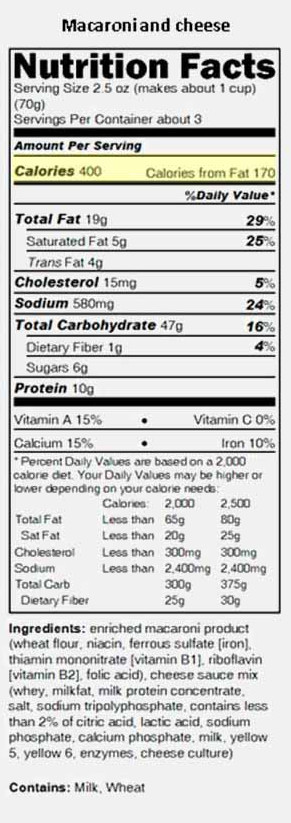
Quiz—
Which of the foods has fewer calories per cup? (Chili)
Which has fewer calories from fat? (Chili)
Daily Values (DV) are the recommended intakes of specific nutrients for adults. The guide at the bottom of the Nutrition Facts Label shows Daily Values for a 2,000-calorie diet and a 2,500-calorie diet. These guides are general dietary advice.
The % Daily Value (% DV) indicates how much of the daily value you get in a serving of food. The % Daily Value is based on the 2,000-calorie diet, which may be more or less than your family members need. For example, if the label lists 8% for calcium (like the chili label), it means one serving provides 8 percent of the calcium you need each day.
- Look for foods lower in fat, saturated fat, cholesterol and sodium. These nutrients may increase your risk of certain chronic diseases. Aim to eat less than 100% of the Daily Value of these nutrients every day.
- Look for foods high in dietary fiber, vitamins and minerals. These nutrients can maintain or improve your overall health. Try to eat at least 100% of the Daily Value of these nutrients every day.
- Foods with 20% DV or more are considered high in the nutrient or an excellent source of the nutrient.
- Foods with 10–19% DV are considered a good source of that nutrient.
- Foods with 5% DV or less are considered low in that nutrient.
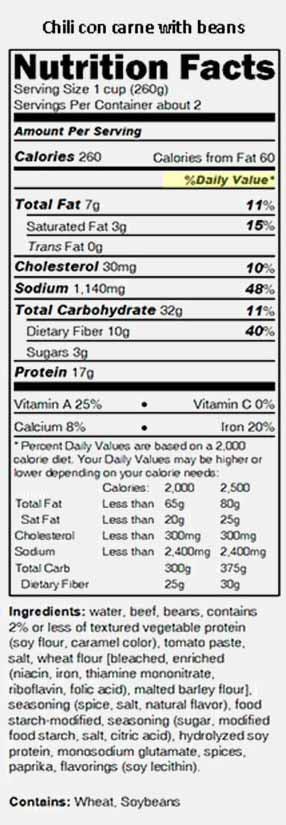
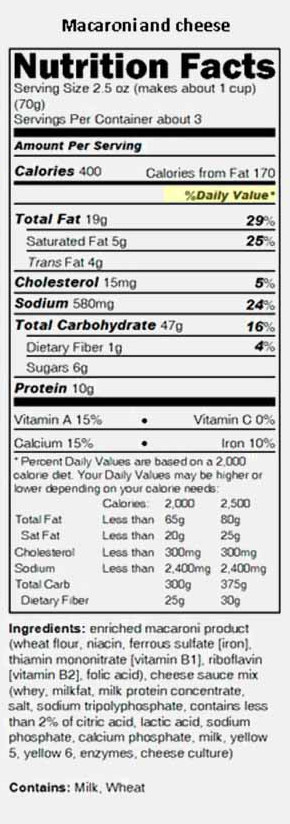
Quiz—
Which food has less sodium per serving? (Macaroni and cheese)
Is macaroni and cheese low in sodium? (No. it would need to have 5% of the Daily Value or less. It has 24% of the Daily Value.)
Which food has more iron per serving? (Chili)
Is a serving of chili an excellent source of dietary fiber? (Yes, because it contains 40% of the Daily Value for dietary fiber.)
Ingredients are listed in order, by weight, from the most to the least amount in the product. For example, the first three ingredients in the chili are water, beef and beans. The ingredients in the macaroni and cheese mix are enriched macaroni product (wheat flour, niacin, ferrous sulfate (iron), thiamin mononitrate (vitamin B1), riboflavin (vitamin B2), folic acid) and cheese sauce mix (sub-ingredients listed).
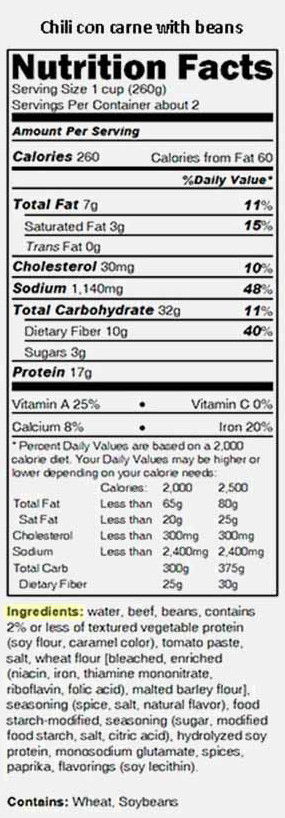
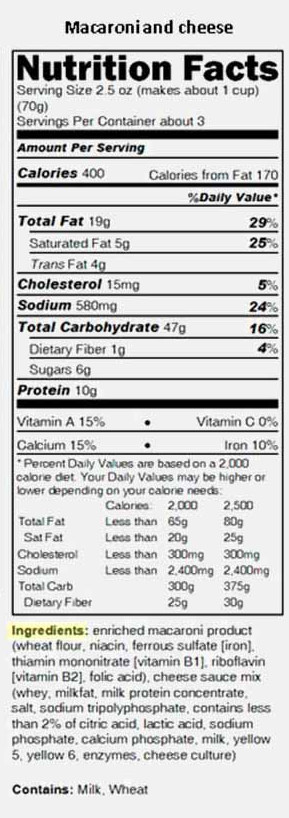
A list of common allergens is also listed. For the macaroni and cheese, wheat and milk are listed. The chili contains soy and wheat.

